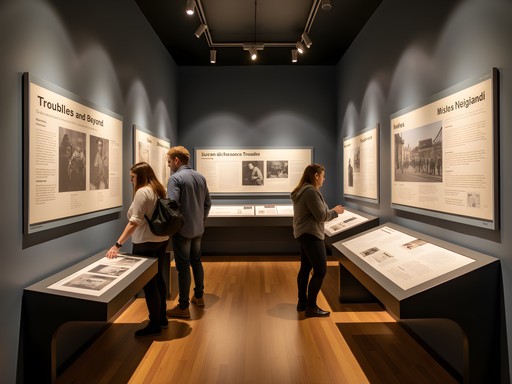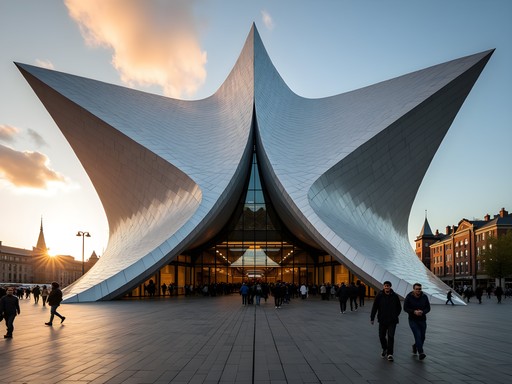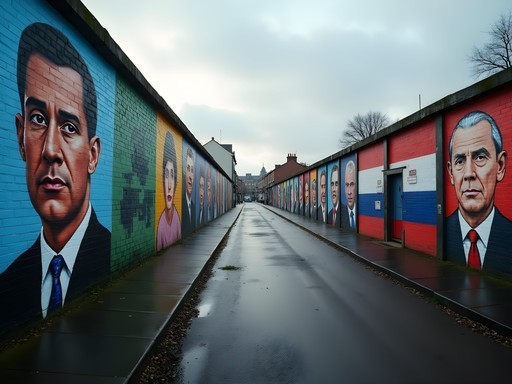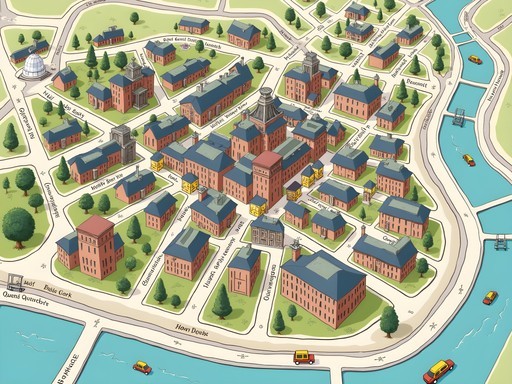Disclosure: This article contains affiliate links. We may earn a commission from purchases at no extra cost to you, which helps our travel content.
As someone who studies migration patterns of endangered species for a living, I've become fascinated by how human populations move and adapt in response to conflict. Walking through Belfast's streets feels remarkably similar to tracking wildlife through changing habitats – each mural, peace wall, and memorial tells a story of adaptation, survival, and resilience. My scientific background might seem worlds apart from political history, but both share a fundamental truth: understanding the past is essential for navigating the future.
The Divided City: Peace Walls and Political Murals
Belfast's peace walls stand as physical manifestations of the sectarian divide that has characterized Northern Ireland for generations. These barriers – some towering up to 25 feet high – were erected to separate predominantly Catholic nationalist neighborhoods from predominantly Protestant unionist areas during the height of the Troubles. As a biologist, I'm trained to observe how physical barriers impact movement and interaction between populations, and Belfast offers a sobering human parallel.
The murals that adorn these communities serve as territorial markers that would be immediately recognizable to any wildlife researcher studying animal territories. The iconic paramilitary murals along Falls Road (Republican/Catholic) and Shankill Road (Loyalist/Protestant) function much like scent markings or visual displays in the animal kingdom – they communicate identity, history, and warnings to outsiders.
During my walk, I used my audio guide to understand the complex symbolism in these artworks. Without proper context, you miss half the story these walls tell. The guide provided historical background that transformed my understanding of each mural from merely observing colorful street art to comprehending profound political statements.

💡 Pro Tips
- Visit both Falls Road and Shankill Road to understand both perspectives
- Join a guided tour led by former political prisoners for insider perspectives
- Bring a small notebook to jot down questions for your guide – the political history is complex
Tracing the Troubles at the Ulster Museum
The Ulster Museum offers a scientific approach to understanding the Troubles that resonated with my research background. Just as I meticulously catalog wildlife specimens and data, the museum presents carefully preserved artifacts, photographs, and testimonies that document this turbulent period.
The 'Troubles and Beyond' gallery particularly struck me with its chronological mapping of conflict escalation – reminiscent of how we track environmental degradation in vulnerable ecosystems. What begins as minor disturbances can cascade into systemic collapse without intervention, whether in rainforest habitats or divided societies.
I spent nearly three hours examining the exhibits, finding unexpected parallels between my work tracking population movements of endangered species and the displacement patterns of Belfast residents during sectarian violence. Both demonstrate how external pressures force adaptation and migration, though the human cost here is painfully evident.
Before visiting, I downloaded the museum companion app which provided additional context beyond the physical displays. The augmented reality features showing how neighborhoods transformed during different phases of the conflict gave me a deeper understanding of Belfast's urban evolution.

💡 Pro Tips
- Allow at least 2-3 hours to properly explore the Troubles exhibits
- Visit on weekday mornings to avoid school groups
- Take advantage of the free guided tours at 11am and 2pm
Crumlin Road Gaol: Behind the Walls
As someone who's spent countless hours in remote field locations, I'm no stranger to isolation. Yet nothing prepared me for the oppressive atmosphere of Crumlin Road Gaol. This Victorian-era prison housed both Republican and Loyalist prisoners during the Troubles, often in separate wings to prevent conflict.
The guided tour takes you through the condemned man's cell, execution chamber, and underground tunnel connecting to the courthouse across the street. What fascinated me most was how the prison environment shaped behavior – not unlike how habitat conditions influence animal adaptations. Prisoners developed complex communication systems, modified their surroundings within strict limitations, and established hierarchies – demonstrating the remarkable human capacity for adaptation even under extreme constraints.
During my visit, I used my pocket flashlight to examine the graffiti etched into cell walls – revealing personal histories that official records often overlook. These markings reminded me of the territorial scratches I document in my wildlife studies, though here they represented something far more poignant: human beings asserting their existence in a system designed to erase their identity.
The most powerful moment came when our guide revealed he was a former prisoner, offering perspectives from both sides of the conflict. His firsthand accounts transformed abstract history into lived experience – a reminder that behind every statistic in my scientific work lies a unique life story.

💡 Pro Tips
- Book the guided tour in advance – they often sell out
- Bring a light jacket as the stone corridors can be cold even in spring
- Ask your guide about the different experiences of political vs. ordinary prisoners
Titanic Quarter: Rebirth and Reconciliation
Belfast's Titanic Quarter represents more than just the birthplace of the famous ill-fated ship – it symbolizes the city's ongoing journey of transformation and healing. As a scientist who studies ecosystem recovery after disturbance events, I was struck by the parallels between ecological restoration and Belfast's urban regeneration.
The award-winning Titanic Belfast museum stands on the former Harland & Wolff shipyard where the original vessel was constructed. While not directly connected to the Troubles, this area represents Belfast's industrial heritage that transcended sectarian divisions – both Catholic and Protestant workers built these ships side by side despite tensions elsewhere in the city.
Walking through the regenerated docklands, I used my water-resistant notebook to document how former industrial spaces have been repurposed into shared civic areas – a process remarkably similar to how disturbed habitats can develop new ecological functions over time. The transformation from conflict zone to tourist destination mirrors natural succession patterns I've documented in recovering ecosystems.
What makes this area particularly significant is how it's become neutral territory in a historically divided city. Unlike the politically charged west Belfast neighborhoods, the Titanic Quarter represents a shared history and future that crosses community lines. During my visit, I observed school groups from both traditions learning about their common industrial heritage – a promising sign for Belfast's continued healing.

💡 Pro Tips
- Book Titanic Belfast tickets online to avoid queues
- Walk the Maritime Mile to fully appreciate the scale of the former shipyards
- Visit at sunset when the building's aluminum façade catches the golden light
Connecting with Local Perspectives
My research training has taught me that the most valuable insights come not from distant observation but from engaging directly with local communities. This principle proved especially true in Belfast, where personal narratives reveal nuances that historical accounts often miss.
I spent an evening at traditional pub, a venue known for its neutral stance during the Troubles. The pub still features the security cage at its entrance – now preserved as a historical reminder – where patrons were once searched for weapons. Today, it hosts traditional music sessions that bring together people from across the political spectrum.
While enjoying a pint of local craft beer, I struck up a conversation with an older gentleman who had lived through the height of the violence. His stories of daily life during the Troubles – navigating checkpoints, avoiding certain neighborhoods, and the constant background anxiety – provided context no museum could fully capture. Most moving was his description of how ordinary people maintained friendships across the divide despite intense social pressure.
For deeper engagement, I joined a black cab tour led by a driver who had personal experience of the conflict. These intimate tours allow for honest questions and complex answers beyond the standard historical narrative. My driver had lost family members during the Troubles yet spoke with remarkable balance about both communities' suffering – a testament to Belfast's ongoing reconciliation work.

💡 Pro Tips
- Respect people's privacy when asking about personal experiences
- Listen more than you speak when locals share their perspectives
- Visit both Republican and Loyalist community centers to hear different viewpoints
Final Thoughts
Walking through Belfast's historical landscape has profoundly shifted my perspective on human conflict and reconciliation. As a biologist who studies endangered species, I'm accustomed to documenting decline – but Belfast offers a rare and hopeful example of recovery after prolonged trauma. The city doesn't hide its scars but rather incorporates them into a new identity that acknowledges the past while refusing to be defined by it.
What struck me most was how the invisible boundaries of the past continue to shape movement patterns through the city – not unlike the habitat fragmentation I study in wildlife populations. Yet Belfast demonstrates that even the deepest divisions can gradually heal with intentional effort and time.
If you're considering this journey, come with an open mind and comfortable walking shoes. Be prepared to hold contradictory narratives simultaneously – this isn't a history with clear heroes and villains but rather a complex web of legitimate grievances, missed opportunities, and ultimately, remarkable resilience. As students of history, we owe it to Belfast's people to listen before judging, to understand before concluding, and to recognize that peace, like ecological restoration, is not an event but an ongoing process requiring constant care and attention.
✨ Key Takeaways
- Belfast's history is best understood through multiple perspectives – make time for both Republican and Loyalist narratives
- The physical landscape of peace walls and murals provides tangible evidence of division and healing
- Local guides who lived through the Troubles offer invaluable context beyond textbook history
- The city's transformation demonstrates how communities can rebuild after conflict while acknowledging painful histories
📋 Practical Information
Best Time to Visit
Spring (April-June) for mild weather and fewer tourists
Budget Estimate
£150-200 for a weekend including accommodation, tours and meals
Recommended Duration
2-3 days minimum to fully appreciate the historical sites
Difficulty Level
Easy - Mostly Flat Walking With Good Public Transport Options
















Comments
Sarah Powell
Your perspective as a biologist studying migration patterns brings such a unique lens to this historical tour. I visited Belfast last year and was equally moved by the Peace Walls. What struck me most was how recent this history is - the guides often share personal stories from their own experiences during the Troubles. The Crumlin Road Gaol tour was particularly impactful - standing in those cells knowing both Republican and Loyalist prisoners were held there, sometimes just floors apart. Did you get a chance to visit the Black Taxi tours? They take you to some areas regular tours don't cover and the drivers often have powerful personal connections to the history.
Genesis Kumar
I did take a Black Taxi tour! Our driver grew up in West Belfast during the height of the Troubles. His personal stories added layers to the experience that no history book could convey. The way he could point to specific streets where events happened was chilling.
wanderdiver
Would you recommend a specific tour guide for the political murals? Going in January and want to make sure I understand the context.
Genesis Kumar
I used Belfast Political Tours - our guide Mark was incredible. Former residents who lived through the Troubles often lead these tours, which adds an invaluable perspective.
blueking4649
Just did this tour last month and it was mind-blowing. The peace walls were so much taller than I expected - really hits home how divided the city was. Our guide was an ex-prisoner who shared his personal story which made everything so real. The political murals were incredible too - so vivid and powerful. Genesis, your perspective as a biologist looking at human conflict is really unique!
Genesis Kumar
Thanks so much! Yes, hearing firsthand accounts from people who lived through the Troubles makes all the difference. Did your guide take you to the International Wall as well?
blueking4649
Yes! The International Wall was incredible - all those solidarity murals connecting to other global conflicts. Really puts Northern Ireland's troubles in a broader context.
redgal
Those Peace Wall murals are incredible. Such powerful imagery. Did you feel safe walking around all the areas?
Genesis Kumar
Completely safe! Belfast today is very welcoming to tourists. Some areas still have tension, but the main routes are well-traveled.
redgal
That's good to know. I've always been interested but a bit hesitant.
Venture X
Premium card with 2X miles, $300 travel credit, Priority Pass